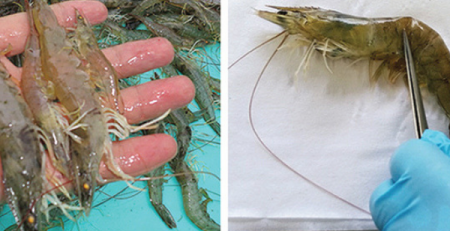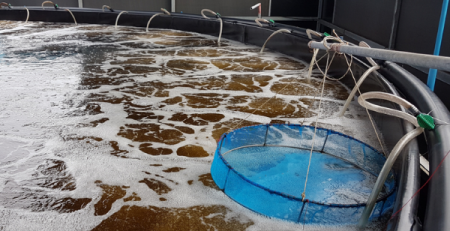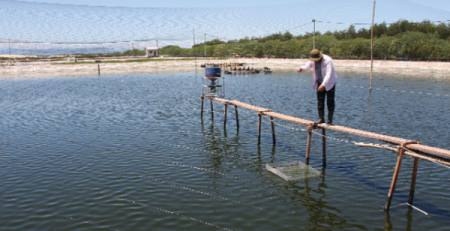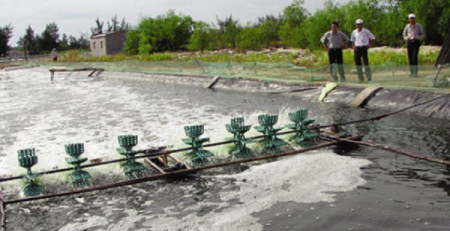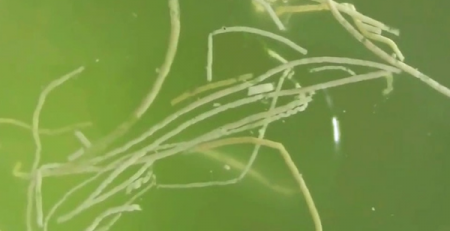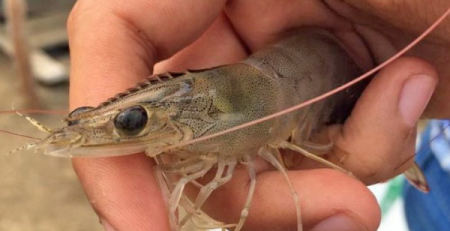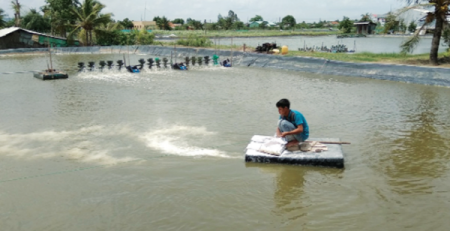Effective turbidity management
Turbidity is one of the factors that affect water quality and pond efficiency. Turbidity can also be reversed by uncontrolled turbid sources without proper and effective management solutions.
ộ đục là một trong những yếu tố ảnh hưởng đến chất lượng nước và hiệu suất ao nuôi. Độ đục cũng có thể trở lại bởi các nguồn đục không kiểm soát được nếu không có các giải pháp quản lý hợp lý và hiệu quả.

Regular inspection of pond environment factors Photo: PTC
Agent
From natural factors: Due to heavy rain, the land is washed away and the sediment is the main cause of turbid water in the pond in the rainy season. Due to the activity of shrimp and other organisms in the pond, the water is cloudy. As clay colloidal particles suspended in ponds are not deposited.
By humans: ponds are not thoroughly renovated, the pond bottom is not clean or the pond is too shallow and the fan is too strong; Use of poor quality lime has many impurities to increase alkalinity before stocking; Using industrial feeds, long-term feeding will accumulate to make pond water turbid.
Harm
Compared with other environmental indicators, turbidity does not directly and immediately affect the growth of shrimp farming, which acts in a quiet manner, slow development, farmers are difficult to recognize. When the turbidity is high, the amount of light entering the pond is low, the photosynthetic intensity of phytoplankton decreases. High turbidity can cause temperature difference and dissolved oxygen dissociation in ponds. It can also cause shrimp clogs or direct injury to shrimps’ tissues, which can interfere with respiration and decrease the preying intensity.
Management measures
Depending on the cause of turbidity, farmers apply different treatment methods. To determine the cause of turbid water ponds need to take some water to the pond filled glass jar then cover and let stand for a week. If the water is still opaque, the cause of turbid water is due to suspended particles. However, if there is water in the bottom of the tank, the cause of turbid water is environmental and biological.
If the turbidity is high, the method is simple to carry out water change. However, it is important to choose the right time for water change. If the pond is cloudy due to mud or soil, then the water is changed then using microorganisms to decompose the sediment in pond bottom. If ponds are chiselled organic material, the water will be mixed with micro-treatment. The pond water is chopped by algae, can be cut algae by lime at night then use microorganisms to kill algae. At the same time, suspended particles can be removed in inorganic salts such as gypsum or aluminum sulphate (Al2 (SO4) 3) to precipitate and precipitate:
Use of Gypsum (Calcium Sulphate): Although not as effective as alum, it can be used at concentrations of 100-300 mg / L (1,000-3,000 kg / ha) to control turbidity. In hard-water ponds (calcium is greater than 50 mg / l), water is almost saturated with calcium, adding plaster will not make the water out of cloudy and plaster may not work. Gypsum should be sprayed throughout the pond surface and as the dissolved gypsum would increase the calcium content in water to improve the conditions for the cotton-making process of the suspended particles.
Aluminum Sulphate (alum): It is a very effective dispersant of suspended solids, low cost of use. Alum alum, however, affects alkalinity in ponds, particularly in reducing alkalinity and increasing acid in water, which can kill fish. Therefore, prior to the use of alum for treating turbid ponds, the pH level should be adjusted appropriately. It is advisable to dissolve aluminum alum in water and throw it over the surface of pond water on a non-rain day. It is possible to use a water / aerator for a few minutes to mix aluminum alum with pond water, but then shut off the engine to cause the floc to settle down. It is important to use enough starting material to make cotton, because aluminum alum does not have a superfluous effect, the aluminum precipitates from water such as aluminum hydroxide within minutes. Care should be taken with the agitator to determine the minimum effective level.
When the sources of turbidity are removed and the water is clear, the total alkalinity should be checked. If the alkalinity is less than 30 mg / L, the use of agricultural lime 2,000 – 3,000 kg / ha. Other options can be used for quick lime but if ponds are stocked, the amount of lime treated should not exceed 50 kg / ha to avoid high pH. Lime treatment can be repeated weekly. In ponds with an alkalinity of more than 40 mg / L, or if lime is not completely chopped, it can be completely muddy by using fertilizers (inorganic) or by treating ponds with coagulants. Or try fertilizing the stools and use the colloids as the final method.
Cre: contom.vn


